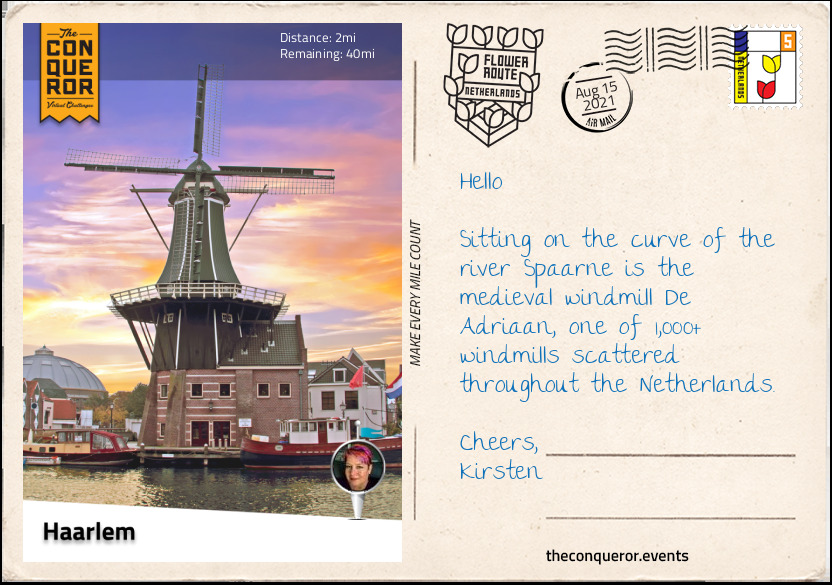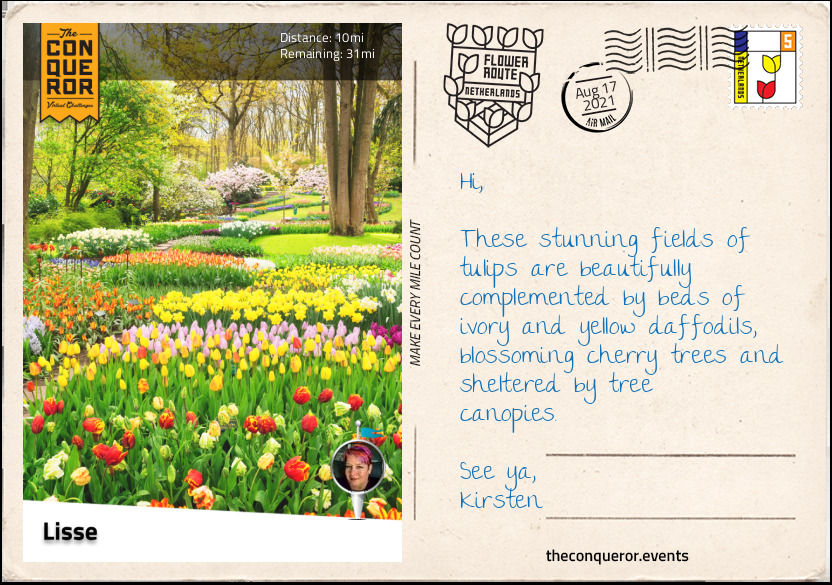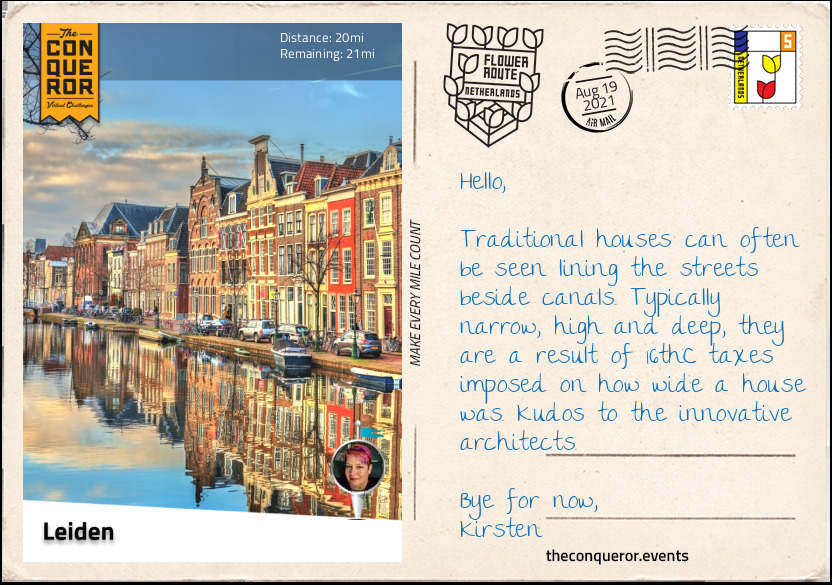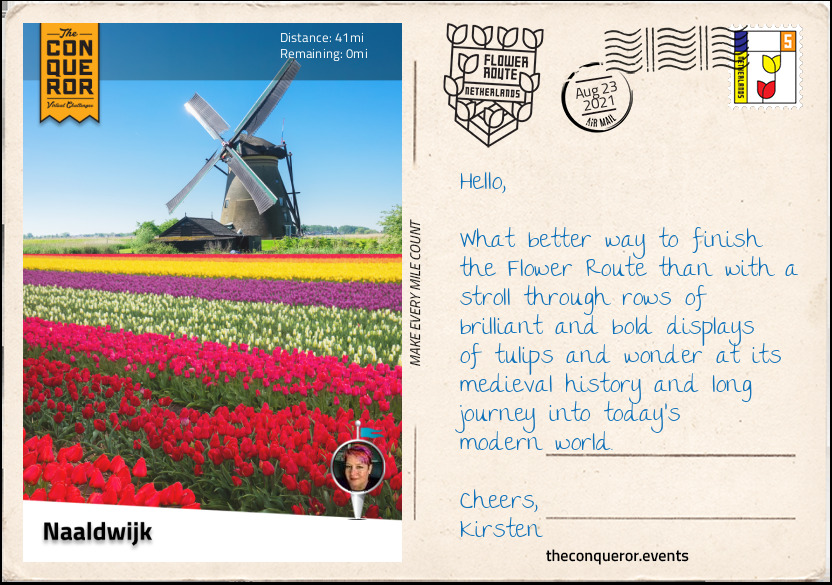 This challenge was short but beautiful.
This challenge was short but beautiful.
Here’s a funny fact: I have been through Amsterdam a bunch of times, as it is a very popular route from Toronto to Johannesburg, South Africa, which is one of the most common connection points to smaller flights within the continent. Schiphol is a lovely airport: tulips, cheese (endless wheels of edam and gouda), KNVB jerseys (our football team of choice when FIFA comes ’round), Delftware, and more. It’s a great place to stretch your legs before the next flight with sone nice long stretches to really work out the kinds. The food is good. The people are fantastic.
But I have never been outside the airport. Not once.
This seems like a terrible shame considering how often I have been there and never once actually planned a stopover that would let me get out and explore the Netherlands. I love what I see on the tourist sites, but in the past I have been terribly destination-centric, not wanting to extend the process of “getting there” or “getting home”. Since most of our trips averaged 24-36 hours of transit time, that does make a certain amount of sense… but it means I have missed out chances to explore places like Japan, Alaska, and the Netherlands, because they I saw them more as fueling stops than places in their own right. It gets worse: I want to go to Japan, and have never gotten outside the airport there, either.
We’re thinking about heading back to Africa (maybe after the long-postponed trip to New Zealand), and this time I should plan to see the Netherlands first for a week before continuing on for a safari in Namibia (maybe a week at Ongava so we can spend some quality time with rhinos). I just wonder what COVID rules will be like when we get around to trying this.
I hope to have a chance to correct this error.
By the way, you won’t be getting one of these celebratory posts for quite some time. I’ve decided to take on The North Coast 500 Virtual Challenge. It will take me through a spectacular 500 mile (806 km) journey through the Scottish Highlands—a scenic route I will be doing in honour of Clan Lindsay.
Postcards

On the banks of the Spaarne River lies the pre-medieval city of Haarlem. Conveniently located only 12mi (20km) west of Amsterdam and 4mi (7km) east of the North Sea beaches, the city affectionately known as ‘Bloemenstead’ (flower city) is the centre of the tulip bulb-growing industry.
First mentioned in the 10th century, Haarlem gained city status in 1245AD and became a walled city in 1270AD. Throughout the centuries, the city has been ravaged by the Black Death (plague) twice; constant fires breaking out burning down numerous buildings; besieged by the Spanish Army during the Eighty Years’ War; and was at the epicentre of the 17th century tulip bulb trading collapse, aka Tulipmania, a time when the cost of a single tulip bulb could trade for ten times the annual salary of a skilled worker.
Yet Haarlem was a major economic hub and the second largest city during the Middle Ages. Due to its geographical location the city was a halfway point on a busy route from Leiden down south to Alkmaar up north. It helped the city grow quickly and industries such as printing, textiles, cotton mills and breweries operated from Haarlem at some point during its long history. Being located on the Spaarne, the city greatly benefited from charging a toll from passing ships and building its own shipyards. The city is also the location for the first tow-canal (animals or man-power towing a barge/boat on a path on the canal’s edge), first railway line and first electric tram in the Netherlands.
Haarlem was a flourishing and wealthy city but by the end of WWII many of the industries had moved to Amsterdam turning a trading city into a commuter town.
Although Haarlem is no longer the once vibrant trading city, it is, however, the starting point for the popular Bloemen Route (Flower Route). For 41mi (66km), the route passes large tulip fields which when in bloom it showcases a kaleidoscope of colour. Tulip season is in spring starting late March for early bloomers and lasts about eight weeks. The month of April is when they are at their best.
The Flower Route though is not just about tulips. Whilst they may be the highlight and synonymous with Netherlands the route begins displaying its colours much earlier in the year when the gorgeous yellow daffodils and purple crocuses appear as the first bloomers between February and March. It is then followed by the second blooming period, end of March to April, with the highly fragrant but short-lived hyacinths in a splash of purple, pink, white and blue. The final blooming period has the revered tulip in a wide array of solid colours such as yellow, red and purple mixed in with variegated varieties. When all the spring flowers have passed, the Dahlias make an appearance in late summer from mid-August to mid-October.
My journey started on Melkbrug, a pedestrian bridge crossing river Spaarne. Taking in the views of the river with its street-lined properties I headed south weaving past two museums: Museum Haarlem telling the history of the city and Frans Hals Museum, a small gallery showcasing Dutch master paintings amongst other artworks, and headed out onto the N208, the tulip fields road.
As I travel along, I ponder the history of the tulip and how it became an icon of the Netherlands and a treasure of the Ottoman Empire. This vibrant flower originally grew wild in the valleys of Tian Shan Mountains, China. First cultivated around 1000AD in Persia (present day Iran), the flower made its way into the courts of the Ottoman Empire in Constantinople by the 16th century. Quickly becoming a favourite the tulip was extensively planted in the Ottoman gardens, used to decorate tiles, embroidered on garments worn under battle armour as a kind of talisman and soon found on carpets and other textiles. Sultan Suleiman the Magnificent (reign 1520-66) loved tulips so much that his clothing was heavily embroidered with this delicate flower whilst noblemen decorated their turban with a single tulip.
Ogier Ghiselin de Busbecq (b.1522-d.1592) was an ambassador to the Ottoman Empire and a keen gardener. He is credited for introducing the tulip to western Europe by bringing them from Constantinople to Vienna. Carolus Clusius, was a gardener in the employ of the Austrian Emperor at the time and Busbecq, his friend, gave him several tulips for the gardens. When relieved of his position by the newly ascended Emperor, Clusius took the bulbs to Frankfurt and then Leiden in Netherlands where through tender care and cultivation the tulip blossomed into a multi-billion euros industry.


Passing through the suburb of Heemstede, from the N208 I can see the elegant country estate of Huis Te Manpad. Built as a country house from 1634-40, the estate was expanded and renovated many times as it kept changing hands just as many times until 1767 when it was purchased by the van Lennep family who owned it for the next 200 years. In 1953 it was bought for the last time by Jan Visser who started a major renovation and restoration and owned it for the next 32 years until he passed away. The estate went into the care of a foundation established by Jan Visser.
On the opposite side is a large field of neatly lined rows of plants in its early stages of growth. The leaves are present but flowering hasn’t occurred yet.
Continuing towards Lisse, I took a right turn onto Veenenburgerlaan, a minor road that is lined with tulip fields all the way to the famous Keukenhof Garden, a 76 acres (32ha) park which each year exhibits its spring-flowering bulbs.
Beginning as a kitchen garden for a 15th century countess, Keukenhof’s gardens were redesigned in 1857. The landscape architects, a father and son team were influenced by the English landscape, thereby forming the basis of the gardens. Within its parkland, Keukenhof has 9mi (14km) of walking paths that meander around ponds, a windmill, greenhouses and water features. In the centre is the Willem-Alexander Pavilion, an indoor display of hundreds of tulips of all forms and sizes. From the whitest of colours to near black, mauve, crimson, double-flowered red with white edges, multi-coloured ruffled petals, fringed edges in bursting orange and of course the classic tulip shape.
Outside the paths were lined with flower beds. A cluster of yellow tulips surrounded a lone tree, whilst delft blue hyacinths hugged the sides of the stairs near the fountain. The meadow near the windmill was dotted with benches out of recycled wood to rest upon whilst mesmerizingly watching the blades turn. Behind the windmill was a narrow canal and the vast fields of bulbs beyond.
Cherry blossom trees were in full bloom in tight clusters of white, whilst the yellow daffodils cheerily lined the path and hugged the side of the Beatrix pavilion. Large logs of wood were placed along the 150 years old Beach Tree Lane. Layered flower beds of hyacinths at the front and tulips or daffodils at the back were planted along the path.
A series of large circular stepping stones were placed on the lake for anyone brave enough to walk it at the same time as being distracted with the beautiful surroundings and camera in hand. What could go wrong, I was thinking tongue-in-cheek?
Tall deciduous trees have yet to grow their leaves allowing light to filter in on the blooming flowers. In summer they provide much needed shade. Various sculptures are scattered throughout the gardens providing other points of interest.
Tucked away in one of the border flower beds was the intriguing tessellated bell-shaped flower known as Fritillaria meleagris. Belonging to the Lily family the flower is less than an inch (2cm) in diameter, with a chequered pattern in purple but can appear in pure white as was evident in this flower bed as the colour white dotted amongst the purple.
Filled to the brim with floral scents I took one more panoramic look at the garden’s colourful displays and exited Keukenhof.
Just before I move on let me share some staggering stats on this magnificent garden. In 2019 the garden was visited by 1.5 million people; each autumn 7 million bulbs are manually planted by a team of 40 gardeners; the bulbs are donated by over 100 growers; it takes two months to complete planting; to ensure continuous blooming over the eight weeks that Keukenhof Garden is open three bulbs are planted in layers in the same location with the shallowest bulb blooming first. Each year a new design is created and close working relationships with the growers who donate the bulbs ensures that the spring display will be at its optimum.
Lisse is an 800-year old town that was once filled with forests, gardens like Keukenhof and large family estates. With the exception of Keukenhof all the rest of the estates were removed and forests taken down to make way for the cultivation of bulb flowers. Increase in employment brought prosperity to the area. The bulb industry boomed in the 20th century which resulted “in the establishment of auction and trading houses, large-scale cultivators and cooperatives”.
I finished the day off with dinner. Starting with a thick split-pea soup called Snert, followed by Zuurkoolstamppot, a sauerkraut and potato puree topped with crispy bacon and ended with Stroopwafels, a “wafer waffle made from two thin layers of baked dough joined together by a caramel filling”.

Starting the day with Poffertjes (mini Dutch pancakes) dusted with icing sugar, I rejoined the N208 and made my way into Sassenheim. The town used to be part of the bulb industry but since WWII it has steered itself towards light industry and residential construction. Most bulb barns have been demolished and bulb lands have disappeared.
The nearby attraction was the ruins of Castle Teylingen, a 13th century stronghold that guarded the north-south route. Currently under state care, the castle was renovated in the 1900s. An interesting castle, it has a concentric outer wall surrounded by a moat. The castle tower built against the wall has a curved rectangular shape four storeys high. Today only the hull remains.
I continued south through several municipalities till I arrived in Leiden, a university city that boasts having the oldest university (c1575AD) and the oldest Botanical Gardens (c1594AD) in the Netherlands. Originally named Leithon, the town began as a settlement around 860 AD. By the 16th century it was a bustling town with flourishing printing, publishing and weaving industries.
A peculiar bit of history was the issue of siege notes during the Spanish invasion in the 1570s. Siege coins were made during this time to support the Dutch cause and they were struck from coin dies onto square silver planchets (metal disks). When Leiden was besieged by the Spanish in 1574, they ran out of silver to produce more coins. Not to be deterred, new “coins” were minted on paper torn out of prayer books. It is believed that this is the first time in Europe that paper notes were issued as currency. An ongoing debate continues whether the currency should be classified as coins because they used coin dies or notes because they used paper. A matter best left to the specialists.
The siege lasted six months from May to October with the Spanish hoping they could starve the town into submission. With no access to food, many suffered illnesses, hunger and starvation but refused to surrender. On 3 October 1574, as the besieged people began to waver, the Dutch cut the dykes flooding the low-lying city but it also provided passage to ships that were carrying food provisions.
Freeing the city, the Spaniards fled in haste leaving behind pots of stew consisting of carrots, parsnips, meat and onions which the Leideners ate. Calling it Hutspot, meaning stew, it became a symbol of their victory and 3 October was declared a public holiday. Commemorating Dutch victory with a festival the city grinds to a halt for two days. On the eve of the public holiday hutspot is served in the city centre and on the morning of the holiday herring and white bread is served at the Weigh House.
For the brave defense of their city the Leideners were rewarded by William I of Orange with their own university. Leiden University opened its doors in February 1575 and currently lists 16 Nobel Prize laureates in areas of physics, chemistry and medicine.
Leiden is also rich in art culture beginning with locally born Dutch painters: Lucas van Leyden (b.1494), Jan van Goyen (b.1596), Rembrandt (b.1606) and Jan Steen (b.1626). The art movement known as De Stijl (The Style) also known as Neoplasticism was founded in Leiden (c.1917) of which Dutch artist Piet Mondrian was a member. Mondrian’s work is easily recognisable with its geometric abstraction often in solid blocks of primary colours.
Famous master painter Rembrandt was born and educated in Leiden. Rembrandt was a draughtsman, painter and printmaker, and his artistic contributions were during the Dutch Golden Age, an era of “great wealth and cultural achievement”. His body of works is extensive with more than 300 paintings, primarily portraits, having been catalogued.
Rembrandt was not known for still life paintings, unlike many 17thC Dutch masters who painted lavishly detailed floral arrangements that inevitably included tulips. However, he did immortalise the famed tulip when in 1634 he painted his wife Saskia as Flora (goddess of spring and flowers) with a wreath of flowers on her head from which a large white tulip with red flame-like lines running from the edges hung on the side of her head. Capitalising on his famous name, bulb traders named similar tulips after him. This striped version of the Rembrandt tulip was referred to as “broken” because the base colour was broken by a secondary colour.
“Broken” tulips were highly prized during the 17th century largely due to their unique colouring and difficulty in replicating. What wasn’t known at the time was that the markings were a result of a virus that infected the flower and weakened the plant. Eventually it became illegal to sell infected bulbs so growers carefully bred a new version of the Rembrandt tulip that is disease-free but still captures some of the original look.
This brings me to Hortus Botanicus, Leiden’s botanical garden where Carolus Clusius, a professor at Leiden University and the garden’s first director planted his collection of tulip bulbs and helped set the foundations for the tulip industry. Carolus was a trained doctor and pioneering botanist with an exceptional reputation and broad international network. Through his contacts Carolus was able to procure an extensive plant collection and when the garden was established it contained over 1,000 different plants in a space barely 114 x 131ft (35 x 40m).
As you can see Leiden is brimming with history and I barely scratched the surface but I’ll wrap it up for now with a climb through 18th century De Valk Windmill and take in the panoramic view of the town then maybe go in search for a bit of Hutspot to fill the belly and rest up for the night.

Now this may not be for everyone but I couldn’t resist starting the morning with Hagelslag, which is toast with butter topped with lots and lots of chocolate sprinkles not unlike the Fairy Bread served at kids’ parties in the southern hemisphere. Apparently it was invented a century ago when the director of a liquorice sweet company wanted aniseed flavoured sprinkles for his bread. Then, it is said, in 1936 a young boy sent letters to a chocolate producing company asking for chocolate sprinkles for his bread. Today there are a wide variety of sprinkles in Dutch supermarkets that are enjoyed by both children and adults.
Hitting the road I left Leiden towards Vlietland, a recreational lake and park with a network of bike paths. From Vlietland, I veered off the main road to connect with the path adjacent to the Vliet canal. Travelling alongside it, as I neared the town of Leidschendam I saw the De Salamander windmill across the canal. Originally built in 1643 but destroyed by fire it was fully rebuilt in 1989 and currently operates as a wood mill. A section of the path is filled with cafes and restaurants with pleasant views of the canal.
Just before the town of Delft the route veered southwest. Whilst no time was spent in Delft, it was worth noting it for its famous blue and white pottery known as Delftware. Delft was the major centre of Delftware production during the 17th and 18th centuries. Of the 30 plus factories that once operated in Delft only one continues to exist today. The Royal Delft Factory has been in operation since 1653 and early in 2021 it successfully received its official museum status.
Connecting to the N222 it became starkly obvious that I arrived at the centre of bulb trading. The small village of Naaldwijk is surrounded by some of the largest greenhouses in the world. Just northeast of the village is the Royal Flora Holland, the largest international flower auction house. Each day it sells over 20 million flowers and each year it turns over more than nearly 5 billion euros. The most popular flowers auctioned are tulips, roses and chrysanthemums.
This brings me to the end of my journey. This delicate looking flower that found its way from the wilds of central Asia into the gardens of Europe and beyond continues to bring joy to plant enthusiasts and whilst the once highly coveted and extremely rare Semper Augustus no longer exists, there is no shortage of colours and varieties to indulge the senses.

